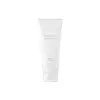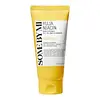What's inside
What's inside
 Key Ingredients
Key Ingredients

 Benefits
Benefits

 Concerns
Concerns

 Ingredients Side-by-side
Ingredients Side-by-side

Water
Skin ConditioningSodium Cocoyl Isethionate
CleansingGlycerin
HumectantHydroxypropyl Starch Phosphate
Sodium Methyl Cocoyl Taurate
CleansingPropanediol
SolventPotassium Cocoyl Glycinate
Acrylates Copolymer
Cetearyl Alcohol
EmollientPotassium Cocoate
EmulsifyingSorbitan Olivate
EmulsifyingSalicylic Acid
MaskingGlycol Distearate
EmollientGlyceryl Stearate
EmollientCitric Acid
BufferingCaprylyl Glycol
EmollientButylene Glycol
Humectant1,2-Hexanediol
Skin ConditioningGlyceryl Caprylate
EmollientCentella Asiatica Extract
CleansingDisodium EDTA
Water, Sodium Cocoyl Isethionate, Glycerin, Hydroxypropyl Starch Phosphate, Sodium Methyl Cocoyl Taurate, Propanediol, Potassium Cocoyl Glycinate, Acrylates Copolymer, Cetearyl Alcohol, Potassium Cocoate, Sorbitan Olivate, Salicylic Acid, Glycol Distearate, Glyceryl Stearate, Citric Acid, Caprylyl Glycol, Butylene Glycol, 1,2-Hexanediol, Glyceryl Caprylate, Centella Asiatica Extract, Disodium EDTA
Water
Skin ConditioningSodium C14-16 Olefin Sulfonate
CleansingCitrus Junos Fruit Extract 11%
Skin ConditioningCocamidopropyl Betaine
CleansingAcrylates Copolymer
1,2-Hexanediol
Skin ConditioningGluconolactone
Skin ConditioningTetradecene
EmollientSodium Chloride
MaskingGlycerin
HumectantHexadecene
SolventSaccharide Isomerate
HumectantCaprylyl Glycol
EmollientXanthan Gum
EmulsifyingSodium Citrate
BufferingCitric Acid
BufferingNiacinamide
SmoothingPropanediol
SolventSodium Hyaluronate
Humectant3-O-Ethyl Ascorbic Acid
Skin ConditioningSuccinic Acid
BufferingHydrolyzed Hyaluronic Acid
HumectantSodium Hyaluronate Crosspolymer
HumectantEriobotrya Japonica Leaf Extract
Skin ConditioningHydrogenated Lecithin
EmulsifyingHydrolyzed Glycosaminoglycans
HumectantPolyglyceryl-10 Stearate
Skin ConditioningPanthenol
Skin ConditioningMentha Viridis Extract
MaskingSodium Acetylated Hyaluronate
HumectantBenzyl Glycol
SolventSodium Ascorbyl Phosphate
AntioxidantEthylhexylglycerin
Skin ConditioningBiotin
AntiseborrhoeicPyridoxine
Skin ConditioningFolic Acid
Skin ConditioningHyaluronic Acid
HumectantRaspberry Ketone
MaskingTocopherol
AntioxidantCyanocobalamin
Skin ConditioningLinoleic Acid
CleansingThiamine Hcl
MaskingInositol
HumectantRiboflavin
Cosmetic ColorantBeta-Carotene
Skin ConditioningDisodium EDTA
Parfum
MaskingLimonene
PerfumingLinalool
PerfumingWater, Sodium C14-16 Olefin Sulfonate, Citrus Junos Fruit Extract 11%, Cocamidopropyl Betaine, Acrylates Copolymer, 1,2-Hexanediol, Gluconolactone, Tetradecene, Sodium Chloride, Glycerin, Hexadecene, Saccharide Isomerate, Caprylyl Glycol, Xanthan Gum, Sodium Citrate, Citric Acid, Niacinamide, Propanediol, Sodium Hyaluronate, 3-O-Ethyl Ascorbic Acid, Succinic Acid, Hydrolyzed Hyaluronic Acid, Sodium Hyaluronate Crosspolymer, Eriobotrya Japonica Leaf Extract, Hydrogenated Lecithin, Hydrolyzed Glycosaminoglycans, Polyglyceryl-10 Stearate, Panthenol, Mentha Viridis Extract, Sodium Acetylated Hyaluronate, Benzyl Glycol, Sodium Ascorbyl Phosphate, Ethylhexylglycerin, Biotin, Pyridoxine, Folic Acid, Hyaluronic Acid, Raspberry Ketone, Tocopherol, Cyanocobalamin, Linoleic Acid, Thiamine Hcl, Inositol, Riboflavin, Beta-Carotene, Disodium EDTA, Parfum, Limonene, Linalool
 Reviews
Reviews

Ingredients Explained
These ingredients are found in both products.
Ingredients higher up in an ingredient list are typically present in a larger amount.
1,2-Hexanediol is a synthetic liquid and another multi-functional powerhouse.
It is a:
- Humectant, drawing moisture into the skin
- Emollient, helping to soften skin
- Solvent, dispersing and stabilizing formulas
- Preservative booster, enhancing the antimicrobial activity of other preservatives
Acrylates Copolymer is used as a film-forming agent and texture enhancer.
After applied, Acrylates Copolymer forms a thin film cover that helps skin feel more soft. It can help sunscreens become more water-resistant.
It is also used to make a product more thick.
Learn more about Acrylates CopolymerCaprylyl Glycol is a humectant and emollient, meaning it attracts and preserves moisture.
It is a common ingredient in many products, especially those designed to hydrate skin. The primary benefits are retaining moisture, skin softening, and promoting a healthy skin barrier.
Though Caprylyl Glycol is an alcohol derived from fatty acids, it is not the kind that can dry out skin.
This ingredient is also used as a preservative to extend the life of products. It has slight antimicrobial properties.
Learn more about Caprylyl GlycolCitric Acid is an alpha hydroxy acid (AHA) naturally found in citrus fruits like oranges, lemons, and limes.
Like other AHAs, citric acid can exfoliate skin by breaking down the bonds that hold dead skin cells together. This helps reveal smoother and brighter skin underneath.
However, this exfoliating effect only happens at high concentrations (20%) which can be hard to find in cosmetic products.
Due to this, citric acid is usually included in small amounts as a pH adjuster. This helps keep products slightly more acidic and compatible with skin's natural pH.
In skincare formulas, citric acid can:
While it can provide some skin benefits, research shows lactic acid and glycolic acid are generally more effective and less irritating exfoliants.
Most citric acid used in skincare today is made by fermenting sugars (usually from molasses). This synthetic version is identical to the natural citrus form but easier to stabilize and use in formulations.
Read more about some other popular AHA's here:
Learn more about Citric AcidDisodium EDTA plays a role in making products more stable by aiding other preservatives.
It is a chelating agent, meaning it neutralizes metal ions that may be found in a product.
Disodium EDTA is a salt of edetic acid and is found to be safe in cosmetic ingredients.
Learn more about Disodium EDTAGlycerin is already naturally found in your skin. It helps moisturize and protect your skin.
A study from 2016 found glycerin to be more effective as a humectant than AHAs and hyaluronic acid.
As a humectant, it helps the skin stay hydrated by pulling moisture to your skin. The low molecular weight of glycerin allows it to pull moisture into the deeper layers of your skin.
Hydrated skin improves your skin barrier; Your skin barrier helps protect against irritants and bacteria.
Glycerin has also been found to have antimicrobial and antiviral properties. Due to these properties, glycerin is often used in wound and burn treatments.
In cosmetics, glycerin is usually derived from plants such as soybean or palm. However, it can also be sourced from animals, such as tallow or animal fat.
This ingredient is organic, colorless, odorless, and non-toxic.
Glycerin is the name for this ingredient in American English. British English uses Glycerol/Glycerine.
Learn more about GlycerinPropanediol is an all-star ingredient. It softens, hydrates, and smooths the skin.
It’s often used to:
Propanediol is not likely to cause sensitivity and considered safe to use. It is derived from corn or petroleum with a clear color and no scent.
Learn more about PropanediolWater. It's the most common cosmetic ingredient of all. You'll usually see it at the top of ingredient lists, meaning that it makes up the largest part of the product.
So why is it so popular? Water most often acts as a solvent - this means that it helps dissolve other ingredients into the formulation.
You'll also recognize water as that liquid we all need to stay alive. If you see this, drink a glass of water. Stay hydrated!
Learn more about Water